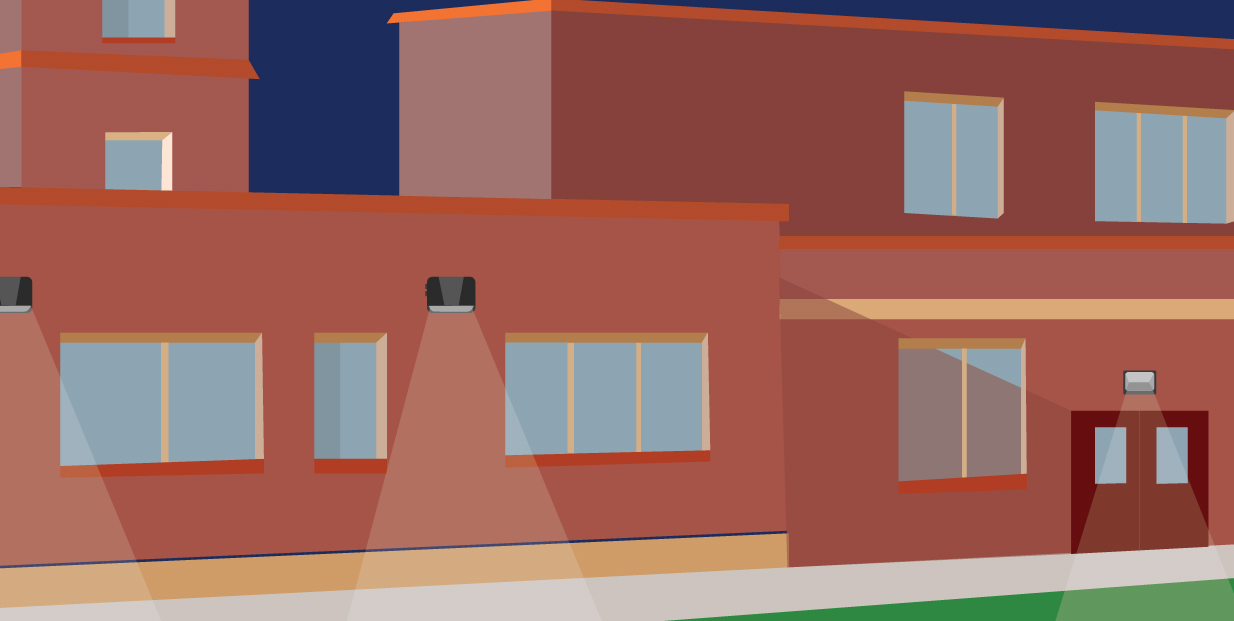Exterior lighting is an essential part of every school grounds. If done right, it provides the students, staff, and surrounding neighbors with safety, security, and peace of mind.
With the arrival of LED technology and lighting controls, exterior lighting can also provide energy and cost savings.
When choosing luminaires for an exterior lighting project, there are many important variables to consider. To help you out we have listed three important exterior lighting factors for three levels of schooling: Elementary & Middle schools, High schools, and University Campuses.
Elementary & Middle Schools
In terms of square footage, elementary and middle schools have the smallest school grounds. They are often in residential neighborhoods and require special considerations.
Glare
Glare is an important safety issue for schools. Glare can be distracting to drivers and may even temporarily blind them. Exterior lighting around a school should limit glare for the safety of students and residents.
When choosing luminaires, you will want to check its BUG rating. The lower the better it is at directing light where it is supposed to go.
Durability
A tough luminaire can absorb the impact of playground ball games and harsh weather conditions.
We recommend wall packs with a polycarbonate lens and die-cast aluminum housing. Accessories, such as a wire guard, can also improve the durability of a luminaire.
Certifications such as IP65, and Approved for Wet Locations are also important to withstand harsh weather conditions.
Light Trespass
Elementary and Middle Schools are common in residential neighborhoods where light trespass is an important consideration. Residents should be comfortable in their homes without unwanted light trespass.
Look for full-cutoff luminaires or consider adding a cut-off shield accessory to your install.
The luminaire’s BUG rating is another indicator of how good the fixture is at directing light where needed. Generally, the lower the BUG rating the better the luminaire is at directing light.
High Schools
Like elementary and middle schools, high schools are also commonly found in residential areas, but with a much larger campus size.
Security
Security is more important for high schools due to higher rates of vandalism. A motion sensor-enabled luminaire works in tandem with security cameras to identify potential vandals.
Motion sensors can also help reduce unwanted light trespass from security flood lights and provide energy savings when motion is not detected.
Energy Savings
A bigger campus size means more luminaires are needed to cover perimeter lighting, multiple entrances, and parking lots. This is where lighting controls can provide big energy savings by dimming or turning off lights during off-hours.
We also recommend switching to LED luminaires for even more energy savings.
Dark Sky Compliance
Having dark sky compliant luminaires helps the residents and wildlife by reducing harmful light pollution.
Blue light is a big contributor to light pollution, try to use warm color temperatures in your install. Full-cutoff luminaires and cut-off shield accessories also help direct light only where it’s needed to reduce light pollution.
University & College Campuses
Large sprawling campuses with different exterior lighting needs. It’s hard to pinpoint just three exterior lighting factors because of the many different types of exteriors on campus (E.g., residential dorms, lecture buildings, parking structures, pathways, sports facilities, statues, etc.). We’re going to focus on the broad lighting best practices for a large University or College campus.
Safety and Security
Exterior lighting is vital to night-time safety and security on campus. Pathways, entrances, and emergency phones should be well lit to provide students and faculty with a sense of security.
Lighting Controls
Simple lighting controls such as timers and occupancy sensors can provide big energy savings for a large campus. Many rebate programs also have a controls element, be sure to check your local rebate program to see which controls are eligible.
Consistent CCT
A college campus will require many different luminaires, make sure you keep a consistent CCT for all of your exterior installs on campus. A consistent CCT improves the overall look on campus and makes it more comfortable for students and faculty.

